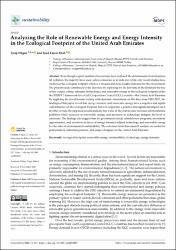| dc.contributor.author | Doğan, Eyüp | |
| dc.contributor.author | Shah, Syed Faisal | |
| dc.date.accessioned | 2022-06-29T13:39:45Z | |
| dc.date.available | 2022-06-29T13:39:45Z | |
| dc.date.issued | 2021 | en_US |
| dc.identifier.issn | 2071-1050 | |
| dc.identifier.other | WOS:000741743800001 | |
| dc.identifier.uri | https://doi.org/10.3390/su14010227 | |
| dc.identifier.uri | https://hdl.handle.net/20.500.12573/1295 | |
| dc.description.abstract | Even though a great number of researchers have explored the determinants of environmental pollution, the majority have used carbon emissions as an indicator while only recent studies have
employed the ecological footprint which is a broader and more reliable indicator for the environment.
The present study contributes to the literature by exploring for the first time in the literature the role
of real output, energy intensity (technology), and renewable energy in the ecological footprint under
the STIRPAT framework for a Gulf Cooperation Council (GCC) country—the United Arab Emirates.
By applying the novel bounds testing with dynamic simulations on the data from 1992–2017, the
findings of this paper reveal that energy intensity and renewable energy have a negative and significant influence on the ecological footprint but real output has a positive and significant impact on it.
In other words, the empirical results indicate that a rise in the real income increases environmental
pollution while increases in renewable energy and advances in technology mitigate the level of
emissions. The findings also suggest that the government should establish new programs, investment
opportunities, and incentives in favor of energy intensity-related technology and renewable energy
for the sake of environmental sustainability. The outcomes from this research analysis are useful for
policymakers, industrial partners, and project designers in the United Arab Emirates. | en_US |
| dc.description.sponsorship | Research Institute of Humanities and Social Sciences at University of Sharjah, United Arab Emirates.
Grant number: 2103030422 | en_US |
| dc.language.iso | eng | en_US |
| dc.publisher | MDPI | en_US |
| dc.relation.isversionof | 10.3390/su14010227 | en_US |
| dc.rights | info:eu-repo/semantics/openAccess | en_US |
| dc.subject | ecological footprint | en_US |
| dc.subject | renewable energy | en_US |
| dc.subject | sustainability | en_US |
| dc.subject | technology | en_US |
| dc.subject | energy intensity | en_US |
| dc.title | Analyzing the Role of Renewable Energy and Energy Intensity in the Ecological Footprint of the United Arab Emirates | en_US |
| dc.type | article | en_US |
| dc.contributor.department | AGÜ, Yönetim Bilimleri Fakültesi, Ekonomi Bölümü | en_US |
| dc.contributor.authorID | 0000-0003-0476-5177 | en_US |
| dc.contributor.authorID | 0000-0003-4874-6509 | en_US |
| dc.contributor.institutionauthor | Doğan, Eyüp | |
| dc.identifier.volume | 14 | en_US |
| dc.identifier.issue | 1 | en_US |
| dc.identifier.startpage | 1 | en_US |
| dc.identifier.endpage | 12 | en_US |
| dc.relation.journal | Sustainability | en_US |
| dc.relation.publicationcategory | Makale - Uluslararası Hakemli Dergi - Kurum Öğretim Elemanı | en_US |


















